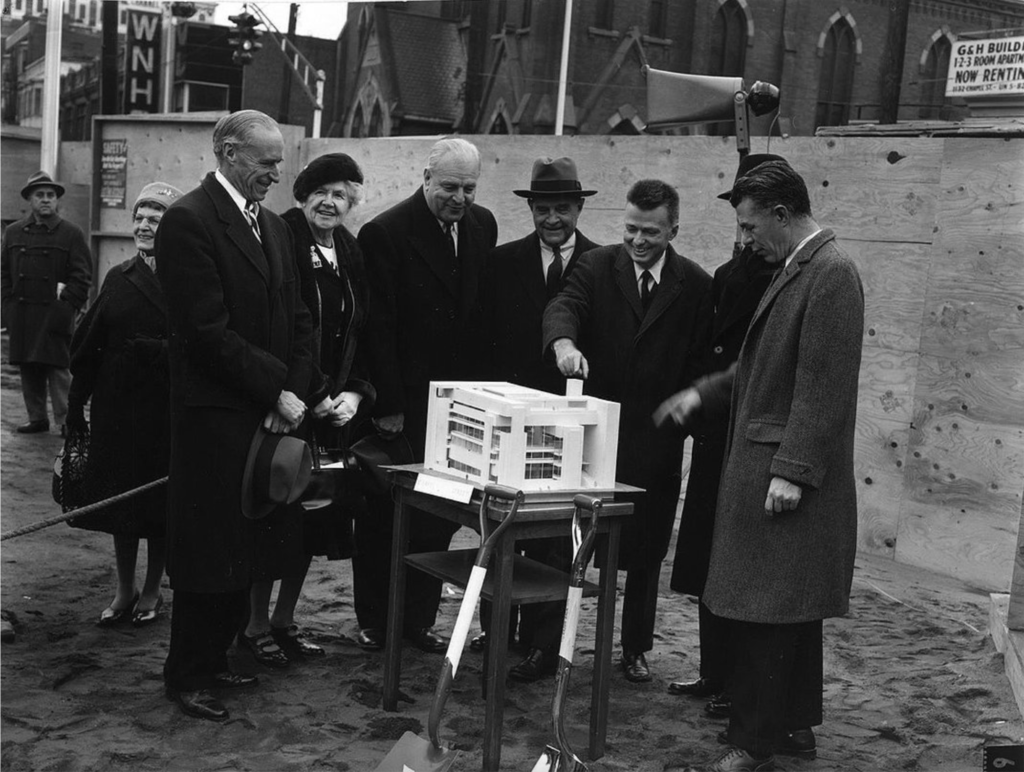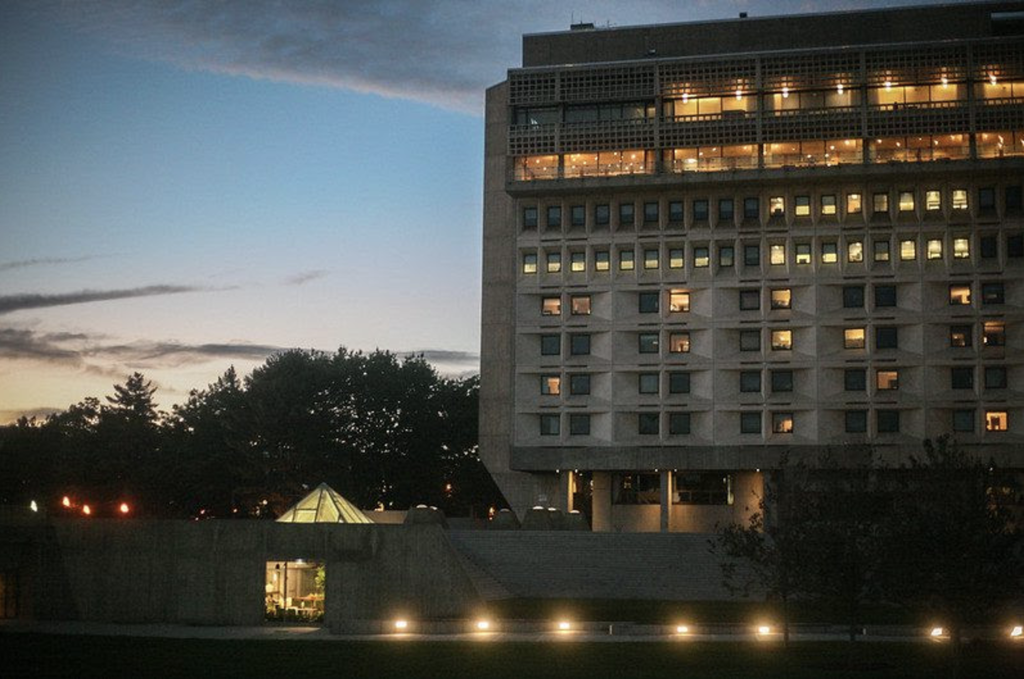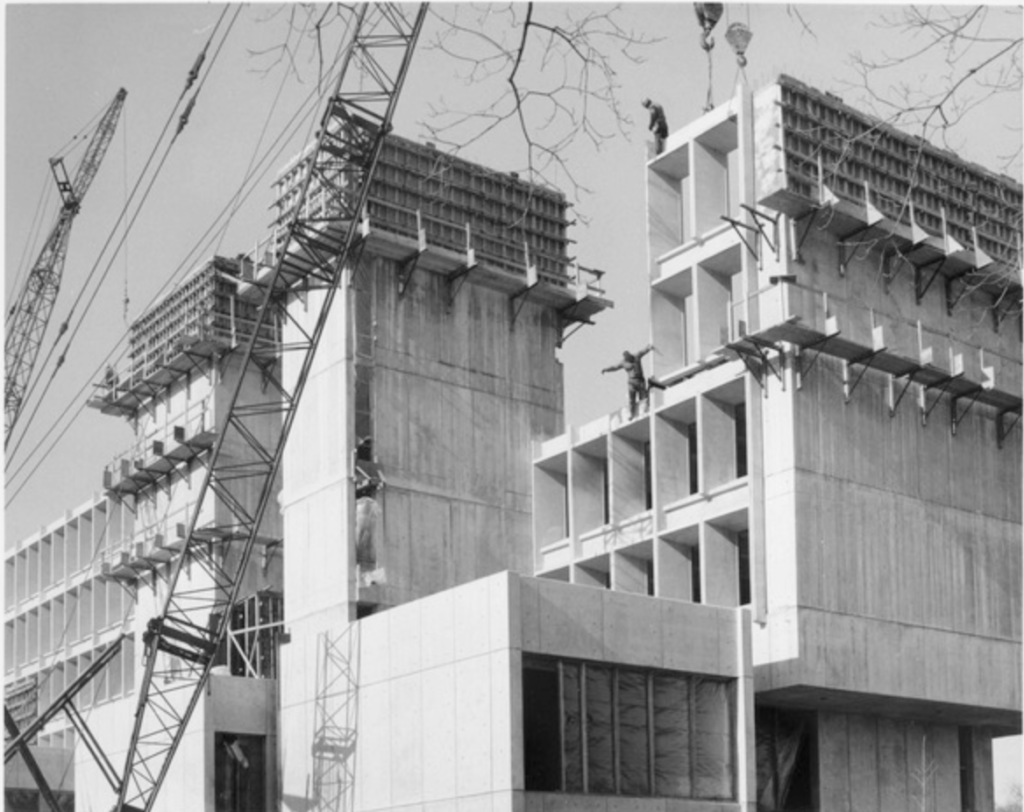Amherst History Month By Month: Brutalist Buildings in Amherst

Bromery Center For The Arts. Photo: umass.edu
Significant architectural styles sometimes come about with birth pangs that linger afterwards. The same could be said for new styles or movements in art, music or fashion. Over time, a 1960s-era architectural style known as Brutalism is one such example; so much so that a campaign to save its “beloved concrete monsters” is now well established and actively vigilant, hoping to preserve its body of work for the ages.
Amherst has several very good examples of this historic building style that is one variant among a few that come under the larger umbrella term of post-war architectural modernism; post-war, but in this case meaning World War II. Almost all of Amherst’s Brutalist architecture is on the campus of the University of Massachusetts in the northern part of town although Amherst shares its ‘collection’ with others worldwide and more locally with UMass Dartmouth, ( see UMassBRUT ) where that entire campus was designed in this style.
Let’s first explore why these buildings were called Brutalist. It seems an apt term to many people including its earliest fans. The buildings look rough, have pointy edges (the Velveteen Rabbit would not approve) and a little forbidding. The term Brutalist comes from the French word ‘brut’ meaning rough or raw – as in the French term “brut champagne” meaning something in its natural state. This is telling because the principle material for all Brutalist buildings is usually concrete crafted in an unadorned way. But an explanation of why the style is so termed may not be enough to convince you of the historic or aesthetic merit of these buildings, if you do not warm to them at first glance. So, let’s try another approach.
In the modern world, concrete has defined a lot of our urban infrastructure from sidewalks and parking lots to more complex architectural structures like bridges and sporting arenas. It is older than most of us think. Brutalism was an economical choice as a way of designing with concrete in mind because it could be pre-stressed and/or reinforced which meant that it could be ‘cast’ in many forms other than rectilinear ones. Architects who designed in this style also liked the way concrete could act like plastic (also much loved in the 1960s) as something that could be molded and worked in many ways. It could also be given a textured surface as demonstrated at the architecture school at Yale, in New Haven, Connecticut, designed by Paul Rudolph, shown below.

In many ways Brutalism heralded a hip, avant-garde ‘look’ that had been used in Europe to usher in the new world of the post- World War II period. As the architectural historian Reyner Banham wrote “….what characterizes the New Brutalism….is precisely its brutality, its je-m’en-foutisme, its bloody-mindedness.” In London, I came of age with the style, and with Rayner Banham who knew my parents, experiencing the “newness” in schemes like the South Bank and the Barbican Center. Other European cities also began ambitious reconstruction programs as they also recovered from World War II.
In Amherst, after the war, the state university ushered in an era of rapid growth in terms of the size of its footprint and in terms of the sheer number of students that were expected to attend. An ambitious new building plan carried the day in 1962, by renowned landscape architect, Hideo Sasaki. Following this, well-known modernist architects were hired to re-envision the campus, a trend underway at other New England universities such as Yale and the University of New Hampshire in Durham, a small farming town, not unlike UMass at Amherst, but on New England’s seacoast.
At UMass Amherst, 27 Brutalist style buildings were constructed between 1965 and 1975, including dorms and academic buildings, the most handsome of which is the Lincoln Campus Center designed by Marcel Breuer.

Other buildings in the same style include the main parking garage, Herter Hall, the Whitmore Administration Building and Tobin, the department of Psychology.
{insert black and white photo here]

Last year in 2021, an indication of how the style is being embraced by a new generation was evidenced by the programming of a two-day symposium Brutalism + the Public University: Past, Present and Future that brought over 100 speakers to both UMass Amherst and UMass Dartmouth to discuss the topic. UMass Amherst also offered the UMassBRUT walking tour and campus guide, and the Brutalism in Color exhibit. Thanks to the many talented people involved in this effort too numerous to mention here. This was a ‘happening” that included a movie projected onto the back walls of the Bromery Fine Arts Center. More programming and resources for the general public are planned. There was even a holiday card featuring the Fine Arts Center that was shared on many different social media platforms.


HNY, Hetty!
As far as early brutalism, there’s a large garden-park (Augarten Wien) along the Danube in Vienna, Austria, which hosts not only a restaurant where Mozart and Beethoven ate, composed, and played, but also two HUGE WWII-era “defense” structures built from multi-meter-thick poured/reinforced concrete:
https://www.pinterest.com/pin/13721973850069395/
https://www.pinterest.com/pin/2251868548397266/
Both are categorized as “Art Deco” architecture, but their sheer scale is… brutal!
Hello and thanks for your comments and picture links, Rob. It is certainly possible to search the globe and find examples that are authoritarian, forbidding and reminders of the horrors of war in this style. There are some observation towers in the Everglades in Florida that are similarly scaled and bleak to look at . But I think its worth remembering that even the most prevalent architectural style known as classicism, that is revived as Neo-classicism in the late 1700s and early 1800s in Europe also has its more authoritarian and in this case, fascistic examples of buildings designed for the Nazis (buildings by Speer for example). Instead, it might be good to mention more humanistic examples of Brutalism such as this (below) for a more balanced interpretation. I was aiming for that. https://goo.gl/maps/NbQvnXxoQxqVCYay8
https://www.halen.ch/
Sehr schön — und Hinweis angekommen!
Vielen Dank ?
P.S. A friend also suggested the “new” UIC campus as an iconic example of brutalism, but I’ve yet to that with my own eyes (unlike the startlingly huge structures at Augarten Wien, so starkly juxtaposed with the 17th century garden, which I almost-literally stumbled upon while visiting my son in Austria about a decade ago .
Rob — The main (non-medical) UIC campus (aka “Circle Campus”) was indeed constructed as a major brutalist installation. The University did a lot of renovations in the 1990s and early 2000s to humanize it — taking down a large concrete raised walkway, for instance, that were unsafe both from snow / ice and from crime. There are interesting politics in that renovation, because the architect, Walter Netsch, was married to Dawn Clark Netsch, who was politically active, and they were both upset by the renovations.
So — I’m always keen to recommend a trip to Chicago for architecture and neighborhood buffs, but Mr. Netsch’s brutalist vision has been obscured …